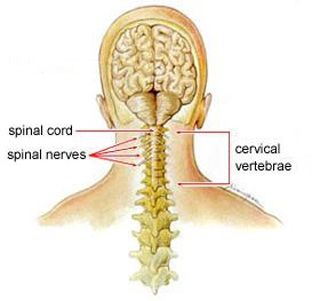Rephrased Paragraph:
The neck plays a crucial role in supporting the head and allowing a wide range of motion. However, its mobility and less protected structure compared to other parts of the spine make it more susceptible to injuries and conditions that can lead to pain and limited movement. While neck pain often resolves on its own over time for many individuals, others may require a professional diagnosis and treatment to alleviate their symptoms effectively.
Rephrased Paragraphs:
Anatomy
The spine is composed of 24 vertebrae, or small bones, stacked vertically. The cervical spine, which forms the neck, consists of the seven smallest vertebrae starting at the base of the skull. These vertebrae, along with supportive ligaments—strong, flexible bands similar to thick rubber—and muscles, provide both stability and mobility to the spine. The muscles are essential for maintaining support and facilitating movement.
Running from the base of the skull to the lower back, the spinal cord passes through the central canal created by the stacked vertebrae. Nerve roots extend from the spinal cord through small openings in the vertebrae, known as foramina, allowing signals to travel between the brain and muscles.
Between each vertebra lies an intervertebral disc, a flexible, shock-absorbing structure that cushions the spine during activities like walking and running.
Cause
Neck pain can stem from issues within the soft tissues—such as muscles, ligaments, and nerves—as well as problems in the vertebrae and intervertebral discs. The most frequent causes include muscle and ligament injuries, like strains and sprains, or chronic wear and tear, often linked to arthritis. In rare cases, infections or tumors can lead to neck pain. For some individuals, issues in the neck can also radiate pain to the upper back, shoulders, or arms.
Cervical Disc Degeneration (Spondylosis)
Cervical discs serve as shock absorbers between the vertebrae in the neck, cushioning movement and reducing impact.
In cervical disc degeneration—a condition commonly affecting individuals over the age of 40—the jelly-like core of the disc begins to break down, causing a narrowing of the space between vertebrae. This reduction in disc space places extra stress on the spinal joints, accelerating wear and contributing to further degenerative changes.
When the outer layer of the cervical disc weakens, the disc may bulge and exert pressure on the spinal cord or nearby nerve roots, resulting in a condition called herniated cervical disc. This herniation can cause symptoms such as pain, numbness, tingling, and weakness in the arms and legs.
Injury
Due to its flexibility and the load it bears in supporting the head, the neck is highly susceptible to injury. Incidents such as motor vehicle accidents, falls, diving mishaps, and contact sports can lead to neck injuries. Consistent use of safety belts in vehicles is a proven measure to help prevent or lessen neck injuries. A rear-end collision, for example, can cause hyperextension—where the neck moves backward beyond its normal range—or hyperflexion, a forward movement beyond safe limits. Soft tissue injuries affecting muscles and ligaments are the most common types of neck injury. However, more severe injuries, involving fractures or dislocations, can damage the spinal cord, potentially leading to paralysis.
When Should You Seek Medical Care?
If intense neck pain follows an injury, such as a car accident, diving incident, or fall, it’s vital to have a trained professional, like a paramedic, stabilize the neck to minimize the risk of further injury or paralysis. Prompt medical care is essential, as immediate treatment can be critical in preventing more severe complications.
Seek medical attention urgently if neck pain from an injury radiates down to the arms or legs.
In cases where radiating pain, numbness, or weakness in the arms or legs occurs without significant neck pain, an evaluation by a healthcare professional is still necessary. Signs such as difficulty with fine motor tasks—like handwriting changes, trouble buttoning, or frequent dropping of small objects—may indicate serious spinal issues.
Regardless of the cause, medical evaluation is recommended for neck pain if it is:
- Persistent and unrelenting
- Severe in intensity
- Accompanied by radiating pain in the arms or legs
- Paired with headaches, numbness, tingling, or weakness


